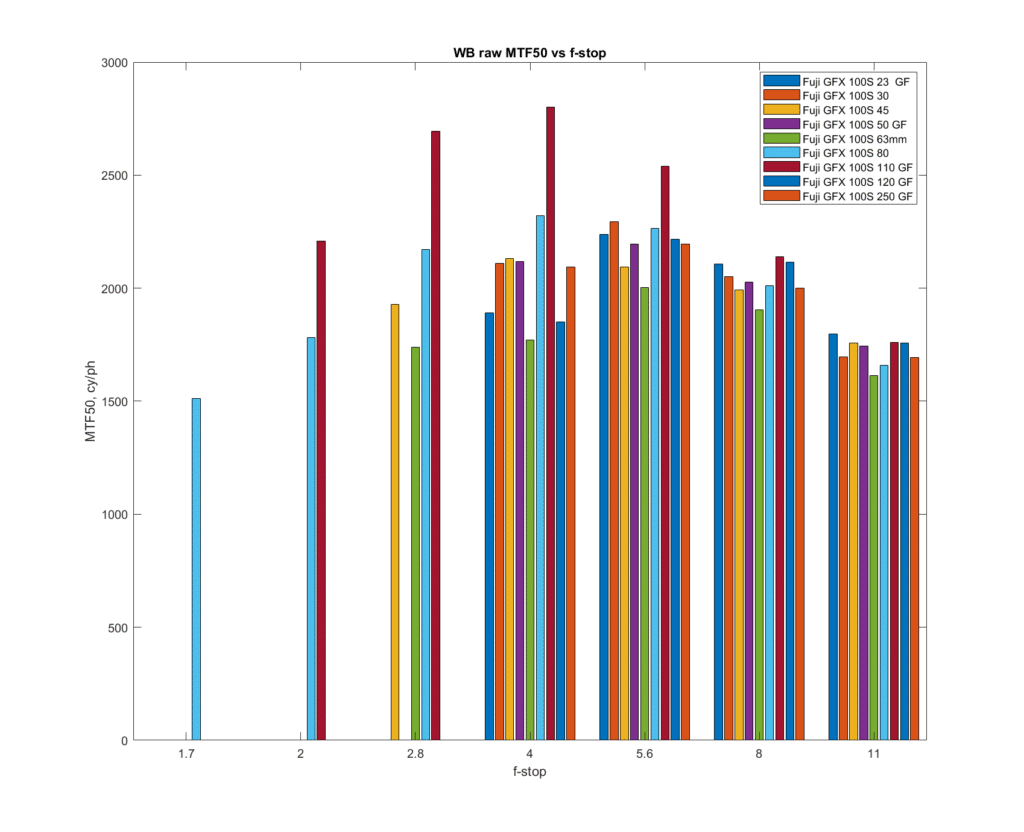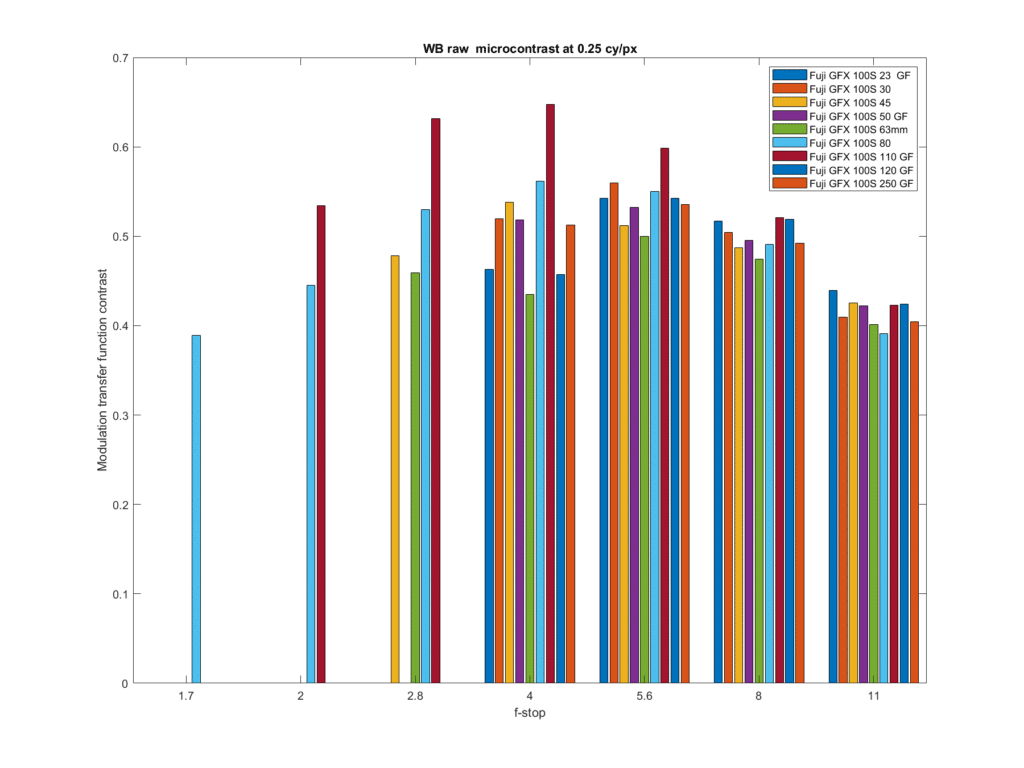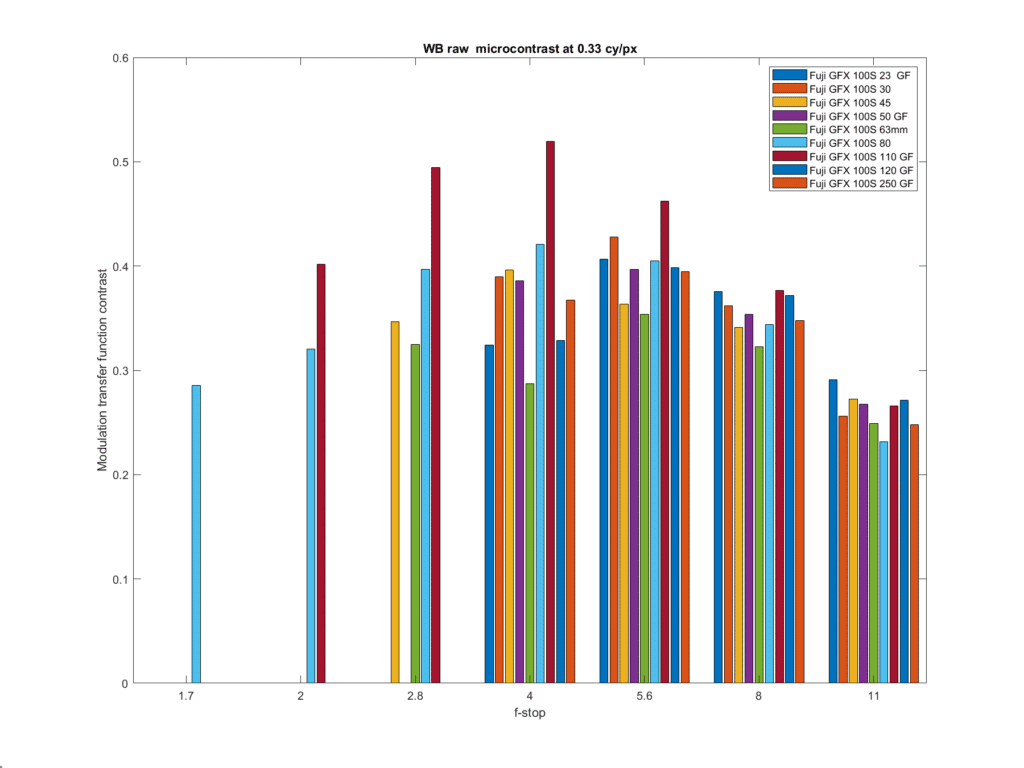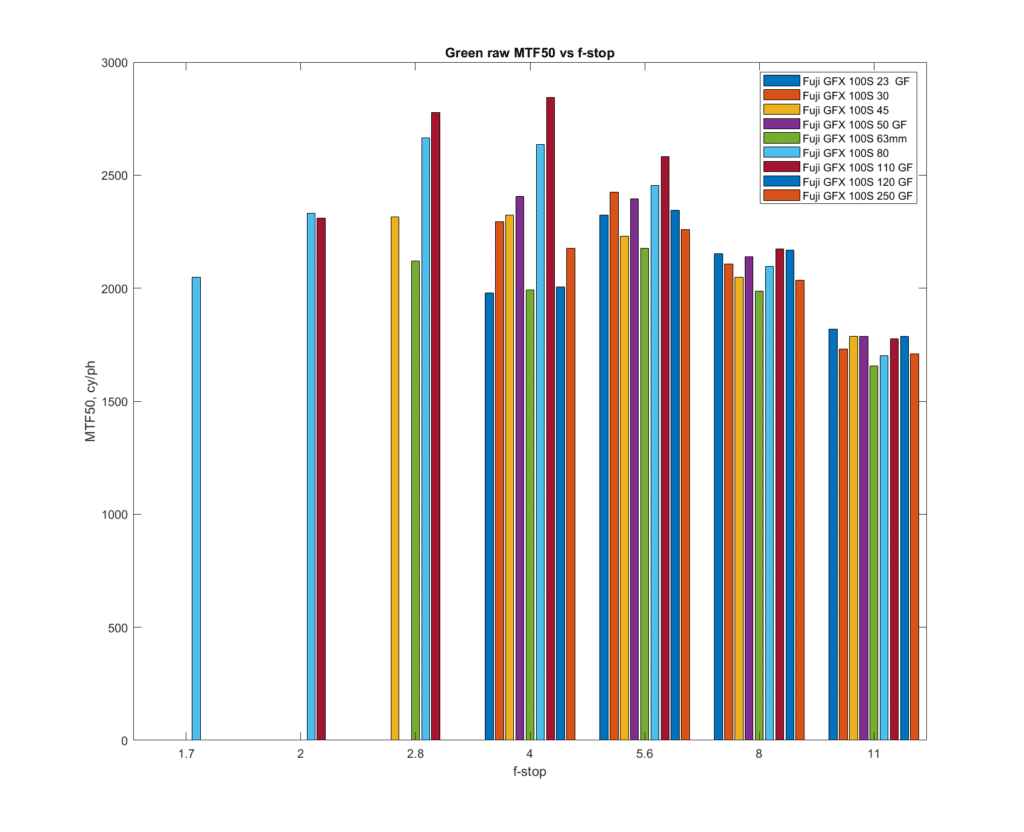This is one in a series of posts on the Fujifilm GFX 100S. You should be able to find all the posts about that camera in the Category List on the right sidebar, below the Articles widget. There’s a drop-down menu there that you can use to get to all the posts in this series; just look for “GFX 100S”.
I’ve shown you some complete MTF curves recently, and I’ll show you more. But when you are comparing many lenses, that’s just too much data to present clearly or to wrap your head around. There are two ways to simplify the MTF curve.
You can pick a contrast level, and measure the spatial frequency where that contrast occurs. The usual convention is to say MTFxx, where xx is the percent contrast. MTF50 is fifty percent contrast, or a 50% loss of contrast. MTF30 is 3o% contrast, or 70% loss of contrast. MTFxx is usually reported in cycles per pixel, cycles per millimeter, or cycles per picture height. The most useful metric for looking at a camera/lens system is cycles per picture height, or cy/ph.
You can pick a spatial frequency, and measure the contrast at that frequency. When the spatial frequencies are in the 0.2 to 0.4 cycles per pixel cy/px) region, the result is usually called microcontrast.
MTFxx is a good way to get a handle on the sharpness and detail possible in an entire photograph. Microcontrast is a good way to understand how a camera/lens system deals with detail that is nearly as fine as it can correctly record.
I’ve crunched the data that I’ve captured for all the Fujifilm GF prime lenses on a GFX 100S both ways.
MTF50 first:
Microcontrast at 0.25 cycles per pixel, which I prefer:
And at 0.33cycles per pixel:
My takeaways:
- As usual, stopping down tends to equalize performance.
- Also as usual, the 110 is the big winner.
- In spite of its LoCA, the 80 doesn’t do badly at all.
Note how good the 80 looks if we only consider the green raw channel:




Quite surprised to see the 120 macro is one of the lower scoring lenses at F4. I recalled the infinity comparison shot with 110 and 120 on GFX50s that the two lenses behaved very similar to my eyes.
I think that shows how good both the lenses are, and to some extent, that the extra sharpness of the 110 doesn’t make that much difference in real-life photography.
Two small thoughts:
1) The GF 110/2 is well corrected for f/2, and that means that it is extremely well corrected for say f/2.8 – f/4
2) Stopping down, diffraction comes into play.
hello
could it be that you mixed up the .33 and .25 cy/px (2nd and 3rd image)?
best, Tom
Thanks. Fixed now.
ps. why do you actually prefer the .25 measurements over the .33?
Tom
0.33 cy/px can occasionally result in color aliasing. 0.25 cy/ox. Is safe. I prefer to not count frequencies that can cause aliasing.
Microcontrast 0.25/0.33 text and graphs are switched. The captions in the graphs are correct.
Thanks. Will fix that.
Excellent comparison Jim.
Are the colors of some lenses the same?
GF23mm/GF120mm Blue?
Gf30mm/GF250mm Orange?
Or is it from my already a little old monitor and the .png?
Are they distinguished on the graph knowing the respective maximum apertures? Thanks.
If the colors look similar, note that the bars are in order of focal length in each f-stop group.
Thanks a lot Jim .-) for the tip.
A perhaps boring question and without undermining your excellent work and blog at all: how are these differences perceived in the real images we produce? Will they be evident enough?
For example, taking the GF30mm/45mm/50mm in F/4; will we see differences in our forographs? Or do the nearly equal bars indicate that in practice we won’t see any differences with our eyes?
In other more obvious cases (the 110mm clearly stands out from the rest); will we see real world differences? Is this a reference for choosing one lens over the other, in the case of close focal lengths (eg 110mm vs 120mm or 45mm vs 50mm)?
Thanks.
The first takeaway is, from the point of view of sharpness, these are all fine lenses, and, with the exception of the 110 and the 80 (and maybe the 63 wide open), performance is similar across the entire prime lens line.
I can tell you from experience that the difference for landscape usage in practice between the 120 and the 110 is subtle, and not important at all for most usage.
One thing to remember is that, in a lens, sharpness isn’t everything, and even when sharpness is important, on-axis performance, which is what is measured here, is not a great predictor of corner performance, especially with short lenses.
“The first takeaway is, from the point of view of sharpness, these are all fine lenses, and with the exception of the 110 and the 80 (and maybe the 63 wide open), performance is similar across the entire prime lens line.” ”
Yea; it seems that 110mm and 80mm start more moderately at maximum aperture and then take the biggest leap to peak performance. The 63mm also starts off more moderately but never improves to the level of others. Even at f5.6 it is below all.
“I can tell you from experience that the difference for landscape usage in practice between the 120 and the 110 is subtle, and not important at all for most usage.”
Perhaps the biggest difference is visible only at f/2 up to f/4 on the 110mm. More pronounced boken? But it’s always the winner of all. Visually the difference will be subtle as you say, in more closed apertures typical for landscape.
“One thing to remember is that, in a lens, sharpness isn’t everything, and even when sharpness is important, on-axis performance, which is what is measured here, is not a great predictor of corner performance, especially with short lenses .”
Sharpness is just one of the aspects that characterize the “personality” of a lens; I agree. There’s the way it render color, image fidelity, the way itdraw the out-of-focus, before and after the the plane of focus and so on. And even mechanical and ergonomic aspects, but these are more or less identical in this excellent Fujinon GF line.
Returning to a concrete example; for those who already have the GF50mm, will it be worth changing it for the GF45mm? Slightly brighter, slightly wider and apparently sharper down to F/4. A little heavier and bigger. At f/5.6 and f/8 the GF50mm wins. Is it just a matter of bokeh (and maximum available brightness) in this case?
This is also why these tests of yours; even if they analyze only a part of the whole picture, as you wrote, are interesting since they allow this analysis side by side along the apertures. Beautiful!
🙂
GF30mm f/3.5 seems also a very good performer .-)
hello again
after checking the charts carefully: I have 2 more questions concerning the 63 mm lens
– why is there dip in performance für both “contrast”charts at f 4? even more pronounced for 33 cycles? could field curvature or focus shift be the reason?
– and why not in the mtf chart?
and, generally: could it be, that you got a “lemon” with your example of the 63 mm? in my experience, also Fujinon GF lenses suffer from some sample variations – during the last months I had the chance to check out every GF focal length in comparison with at least one other copy. The variations were not so strong, as known from other brands, but sometimes already visible with a short brick wall test. And it seemed to me, that the “older” production models were more affected.
Additionally, could it be, that the performance of the different “tested” lenses depends on the distance to the target – if you don’t meet the optimal distance, the IQ decreases?
Another thing, which would be interesting for me (and others perhaps): a comparison of selected primes, e.g. new Sony or Sigma mirrorless lenses like 35, 50, 85 mm (perhaps not Canon because they still stick with the AA / low pass filters)
best, Tom
It can’t be explained by either field curvature or focus shift because of teh focus bracketing test methodology I used, which calibrates both of those out.
That looks at a different part of the MTF curve, MTF50.
It’s conceivable. I only have one copy of the 63.
Of course. All the lenses were tested at the same magnification. The subject distance for the 63 was 5.5 meters.
I think there could be something wrong with your copy of the 63. I always got the impression that my 63 wasn’t too far off from my 110. And aren’t nifty 50s usually among the sharpest lenses in any lineup?
I’d have to use a different methodology. Sony doesn’t support focus bracketing.
Hi Jim,
why, in your opinion and tests, do these lenses peak at f/4 or f5.6 and then start to decay? Diffraction from f/8?
In the specific case of real estate photography where I want good general sharpness and full focus on the whole scene, should I stop at f/5.6, for example when I use the GF 30mm f/3.5? Or should I go further to f/8 or f/11?
Thanks.
Diffraction causes the loss in sharpness as you stop down. How for you should stop down beyond the sharpest f-stop depends on how much DOF you need for your subject.
https://blog.kasson.com/the-last-word/optimizing-f-stops-and-focus-distance-for-landscapes/
Thank you so much Jim for the explanation. Can you confirm that the loss of sharpness on these GF lenses after sharpest f-stop is due to diffraction?
It is, indeed.
Hi Jim,
very grateful for your answer. I didn’t expect diffraction so “early” right after f/5.6, but there must be an explanation that eludes me; big sensor?
Regards
Diffraction operates at all f-stops. When the sharpness starts to drop is when the degradation of the diffraction overcomes the reduction in lens aberrations as you stop down.
I understand. Always learning ,-) Thank you.
The sensor size is not the key issue here if you think in terms of equivalent apertures. The quality of the lens is an important issue.
Ok. It’s the delicacy of physics at work ,-)
I assume that lenses from other manufacturers, adapted, even of good quality but designed for Full Frame, grosso modo, always have a worse behavior than the native ones?
That’s not true all the time. If a FF lens has good coverage on 33×44, it can have as good or better performance than a native lens (although it usually doesn’t). The CV 125/2.5 Apo-Lanthar is an example. That’s a better way to get to 1:1 than putting a 45mm tube on the 120 GF.
Ok. Maybe the Zeiss 2/135mm APO is another good example?
Yes, but there is no GF equivalent of that lens.
Right.
Jim,
comparing your Raw MTF50 cy/ph graphics for the GF30mm and the GF32-60mm (another post), I see that the GF30mm at f/5.6 (its peak) reaches a mark between 2000-2500 (I can’t pinpoint the value).
Does the zoom on the 32mm at f/5.6 (at its peak) go up maybe a little more than the prime? And at 44mm it goes up to 2500.
Does this mean this GF Zoom is better at both 33mm and 44mm than the prime GF 30mm? Or am I reading the graph wrong?
Thank you very much.
It’s not all that simple. Compare this:
https://blog.kasson.com/gfx-50s/new-presentation-of-on-and-off-axis-contrast-of-all-gf-primes/
with this:
https://blog.kasson.com/gfx-50s/off-axis-contrast-of-all-fuji-gf-zooms/
Look at the off-axis values in both directions.
I’d question the utility of looking too hard at such small differences. I think the long pole in the tent is more likely to be the field curvature of the 32-64, or other characteristics besides pure sharpness.
I’ve seen the links; thanks. I understand what you mean .-)
What could explain lenses trading places in performance as you stop down (like, the 80 outperforming the 63 at f8, but the reverse at f11)? Why wouldn’t diffraction degrade both equally, and keep their relative positions?
Could these differences just be within the range of experimental error?
Lens aberrations and diffraction interact in strange ways because of phase effects.
Sure.